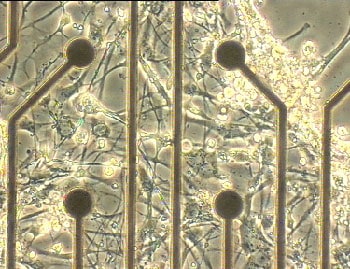The way that neurons are linked together in the brain has long fascinated both physicists and biologists. Researchers at the University of Tel-Aviv in Israel have now shown for the first time that neurons can self-organize themselves into electrically active clusters of cells in the laboratory. The clusters are linked together by bundles of axons (R Segev et al. 2003 Phys. Rev. Lett. 90 168101).

Eshel Ben-Jacob and colleagues used an in-vitro technique to study the effect of cell density on the formation of neuronal clusters. The researchers grew cultures of rat-brain neurones on top of a silicon nitride surface and followed the development of the networks with time-lapse video recording. They found that the network, which is initially uniform, separates by the creation of ‘borders’ that break it into separate ‘basins’. Each basin then collapses into a cluster, which remains intact until it degrades 3 to 4 weeks later (see figure 1).
The scientists found that the network only evolved into clusters when the cell density was greater than 10 000 cells per square millimetre. The clusters, which each contain around 10 000 cells, are about 250 micrometres across and are inter-connected by axon bundles 10 micrometres in diameter. The Israeli team also measured the electric signals fired by cells grown on top of an array of microelectrodes (see figure 2). It found that the neural networks were able to self-control the strength of their interconnections, and their shape, to maintain the required level of electrical activity.
Ben-Jacob and co-workers say that their results “might provide important clues towards understanding self-organization in the central nervous system and the brain itself.” The group now plans to grow well-defined networks and compare their development with those of randomly grown ones.




